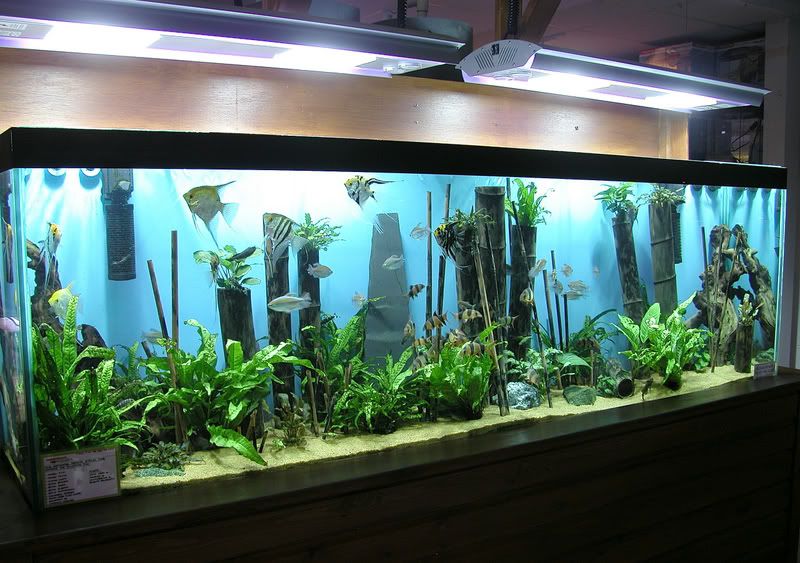Re; bamboo for loach hide-outs:
How do you get it to sink? Will it eventually sink with soaking?
Decomposition? Are there types/species of bamboo to be avoided?
A
Bamboo habitat
Moderator: LoachForumModerators
Bamboo habitat
"I can eat 50 eggs !"
-
mickthefish
- Posts: 3281
- Joined: Sun Sep 10, 2006 7:20 pm
- Location: manchester, england
- Emma Turner
- Posts: 8901
- Joined: Wed Dec 28, 2005 5:07 pm
- Location: Peterborough, UK
- Contact:
The first time I did the display tank at the shop with bamboo (large upright pieces) I had little trouble. I used an aquarium-safe 2-part putty (as is used for fragging corals) to stick the bottom of each piece to reasonably sized pieces of slate. This slate was then buried in the sand substrate:

2004
The second time around, however, the bamboo ended up being much more bouyant (it did look the same, but was from a different source). Despite puttying it to the slate as I did before, most of it ended up floating. I was highly stressed out at this point as I was working on this after the shop was closed and only had so many hours to sort out the mess I'd made. I ended up having to drill lots of small holes in the back of each piece of bamboo (done so it couldn't be seen from the front) in order for each section to fill up with water. Any pieces that happened to be cut so that there was a large hollow section at the top, had that filled with gravel as well. Each piece had to be held down until it filled with water and eventually sunk.

2007 (just after adding the new bamboo - hence the yellow colour - this soon turns browner and gets covered in algae).
Of course, if you are planning to use the bamboo as horizontal tubes, cutting each section so that it has no middle chamber (i.e. cut each piece just before the dividing 'skin' in each section) and sticking to slate - either permanently with aquarium safe putty, or temporarily somehow until the bamboo becomes waterlogged - should work.
I should just point out that bamboo must be used carefully in a closed aquarium system as it does rot down over time. This is not a problem in the large display tank at work because of the amount/volume of water changed every day, but large amounts of bamboo in smaller tanks that are not waterchanged so frequently can cause major problems.
Hope this helps,
Emma

2004
The second time around, however, the bamboo ended up being much more bouyant (it did look the same, but was from a different source). Despite puttying it to the slate as I did before, most of it ended up floating. I was highly stressed out at this point as I was working on this after the shop was closed and only had so many hours to sort out the mess I'd made. I ended up having to drill lots of small holes in the back of each piece of bamboo (done so it couldn't be seen from the front) in order for each section to fill up with water. Any pieces that happened to be cut so that there was a large hollow section at the top, had that filled with gravel as well. Each piece had to be held down until it filled with water and eventually sunk.

2007 (just after adding the new bamboo - hence the yellow colour - this soon turns browner and gets covered in algae).
Of course, if you are planning to use the bamboo as horizontal tubes, cutting each section so that it has no middle chamber (i.e. cut each piece just before the dividing 'skin' in each section) and sticking to slate - either permanently with aquarium safe putty, or temporarily somehow until the bamboo becomes waterlogged - should work.
I should just point out that bamboo must be used carefully in a closed aquarium system as it does rot down over time. This is not a problem in the large display tank at work because of the amount/volume of water changed every day, but large amounts of bamboo in smaller tanks that are not waterchanged so frequently can cause major problems.
Hope this helps,
Emma

East of the Sun, West of the Moon.
Who is online
Users browsing this forum: Google [Bot] and 131 guests